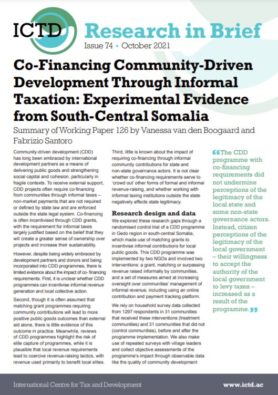Research in Brief 74
Community-driven development (CDD) has long been embraced by international development partners as a means of delivering public goods and strengthening social capital and cohesion, particularly in fragile contexts.
To receive external support, CDD projects often require co-financing from communities through informal taxes – non-market payments that are not required or defined by state law and are enforced outside the state legal system.
Co-financing is often incentivised through CDD grants, with the requirement for informal taxes largely justified based on the belief that they will create a greater sense of ownership over projects and increase their sustainability.
However, despite being widely embraced by development partners and donors and being incorporated into CDD programmes, there is limited evidence about the impact of co- financing requirements. First, it is unclear whether CDD programmes can incentivise informal revenue generation and local collective action.
This is a summary of Working Paper 126 by Vanessa van den Boogaard and Fabrizio Santoro.
